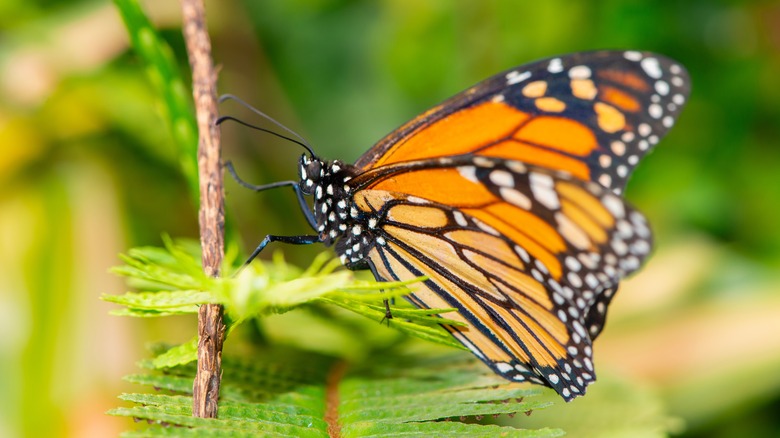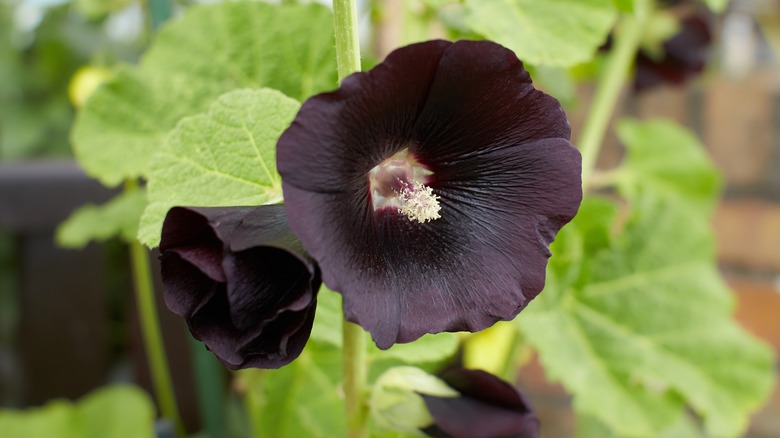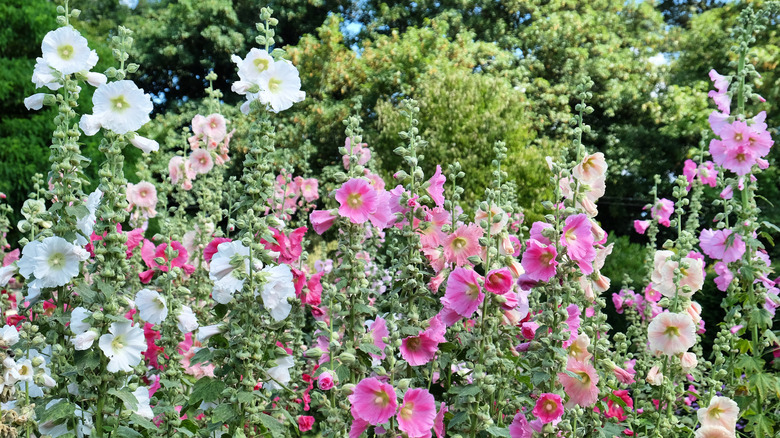Add A Touch Of Mystery To Your Garden With This Black Flower That Pollinators Love
If you're eager to jump on the "summerween" trend and are searching for a spooky plant that will look right at home with your Halloween decor, or you're otherwise perfecting your goth cottagecore aesthetic, it's hard to go wrong with the dark mystery of plants that grow black flowers or foliage. One particularly stunning choice for an elegant black flower garden is the Black Watchman variety of hollyhock (Alcea rosea "Watchman"): With flower spikes that can reach 5 to 8 feet tall, heart-shaped leaves, and poppy-like blooms in a deep reddish black, it's hard to resist this tall, striking plant.
If their unique heirloom flowers aren't enough to convince you to run straight to the garden store, Black Watchman hollyhocks boast a few additional characteristics that might endear you to them. Like other hollyhocks, they attract pollinators such as bees, hummingbirds, and butterflies, and they're resistant to damage from rabbits. They can also tolerate the toxin secreted by black walnut trees, called juglone, making them a pretty choice for planting beneath black walnut trees. Hollyhocks are nontoxic to pets and even edible for humans. But of course, it's the dark, abundant flowers that draw us to the Black Watchman variety of hollyhock in particular, and with proper planning, they're fairly easy to grow.
How to grow Black Watchman hollyhocks
For the quickest blooms, direct sow seeds in early spring after the last frost, keeping the soil moist during the germination period. You can also start your seeds indoors eight weeks before the last frost if you prefer, but direct sowing is recommended over this technique. If planted early enough, Black Watchman may flower by summer of the same year, but seeds can also be planted later (through August/September) for blooms by the summer of the following year. Hollyhocks can tolerate a variety of soil conditions, and once established, they can be deadheaded after the first round of blooms for a second fall bloom. Though they are technically perennials, hollyhocks are talented self-sowers and can reseed for several seasons' worth of blooms.
Plant Black Watchman seeds 6 to 8 inches apart in full sun at a depth of ½ an inch. To make the most of the towering height of these hollyhocks, gardeners recommend planting them as a border plant or against walls and fences for an especially striking contrast.
Possible challenges in growing hollyhocks
With hollyhocks like the Black Watchman variety, patience is a virtue. As mentioned above, unless your timing is quite exact, you likely won't see blooms from your plants until the following summer. While overwintering your seeds, be mindful of moisture levels — if you're in a region with wet winter soils, hollyhocks might not be the best choice for you, as this is one soil type in which they cannot thrive. But even if you know everything you should know before planting hollyhock, there are a few susceptibilities you may not be able to avoid.
Hollyhocks are prone to damage from a few types of pests, including Japanese beetles, slugs, and spider mites. They can also be affected by anthracnose and leaf spots, and in particular, an infection known as hollyhock rust. Hollyhock rust can cause leaf spotting and dropping, and it can be difficult to control among plants in the mallow family. If rust afflicts your Black Watchman hollyhocks, remove affected leaves as early as possible and use a hollyhock-safe fungicide to stop the spread. Unfortunately, Black Watchman is not among the listed varieties that are more resistant to hollyhock rust within the Alcea family, so keep a vigilant eye out for early signs. Luckily, even if the foliage of your hollyhocks is affected by rust, it typically doesn't affect the flowers of the plant, so we think it's well worth the risk for such deep, dark blooms.


